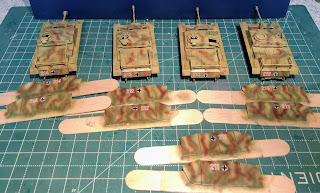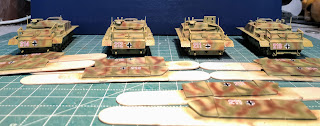 |
Rubicon Models STuG III ready for paint
|
I started the STuG III project much earlier in the year and they have been languishing on the back of the workbench for some time now. As the U304 (f)s near completion I have pulled these out to figure out exactly what I wanted to do with them. Work has been held up for a couple of different reasons, I wanted to practice the weathering techniques that I have been using on the 21st Panzer Division vehicles and I wasn't quite sure which unit I wanted to model.
At this point I'm pretty confident with the weathering techniques and while there is always more to learn I feel that I can really do justice to the STuGs at this point. I was still undecided about the unit though, I have been flipping through a couple of books but in one of them there is a picture of a single STuG from the 343rd Battery. It has the heavy green and brown camo characteristic of the late war, and it has somewhat unusual side skirts which intrigued me. The picture indicated that these style skirts were unique to this particular unit (always a bonus in my mind). These are the standard skirts with the top of the skirting on the first three panels bent inwards. No idea why someone would do this, I don't see any gain to protection. From an armor perspective those skirts are quite thin from a metal working perspective that would take some serious effort by the maintenance unit. These STuGs also have a debris shield over the gun mantlet which would be easy to model as well (I hope anyway).
The question becomes can I modify the Rubicon skirts to reflect this interesting skirt modification? I figured I could sacrifice three panels without a problem, missing panels wouldn't be uncommon or one STuG (well probably the STuH) could go without skirts.
 |
The first mark, time to get cutting
|
Pushing everything else to the back of the desk I proceeded to start cutting up the side skirts. The toughest one is the front panel. In addition to the bend in the armor it has been cut down to reveal the entire drive wheel, I guessing for maintenance reasons. Determining the point of the cut was a little difficult since I had already cut the skirts panels apart from each other (perhaps I should have waited till after the painting was finished to do this, will remember that when I get to the PzKfw IVs). I lined everything up starting with the back skirt and its location relative to the return wheel and then sort of pushed everything in place till I got to the front panel and marked the positioning. The cut was made from the mark on the bottom of the panel to the upper right corner. So far so good, a small quick vertical cut to match the picture and the easy part was done.
 |
Everything marked, cut and bent
|
I flipped the panel over and measured on 1/8th inch down from the top of the shield, well two marks one on the front edge and one on the back edge, and proceeded to make a shallow cut here. I worked slowly since I didn't want to cut the panel and reattach it I just wanted to bend it. I made shallow cuts and then widen it on the bottom edge with a angled cut. I placed the top edge on the workbench and gently pushed, if it didn't bend I made another shallow cut, until it bent into the position I wanted. I did the same thing on the center skirts, which were much easier. The bend in the front shield required another vertical cut so it would line up straight with the next panel.
 |
From the front, the important side and it looks pretty good.
|
With that accomplished and the skirt panels lined back up for a quick visual check I was pleased enough with the result to do it on the rest of the skirting. I do wish I had found this picture before I had primed and based coated the STuGs! Live and learn, at least with the Jagdpanthers I already know which unit I want to represent and I planned the modifications in advance.
 |
| Looks good from here and the panels are behaving the way I envisioned them, kind of loose and out of place. |
 |
| The real work begins. |




































